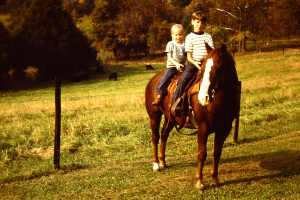
Sep 29, 2020 | Adventure, Authenticity, Courage, Freedom
 Growing up on a farm, my big brother, Lee, and I filled our days playing with cows and horses, riding our dirt bike, fishing tadpoles out of the creek, and making forts from hay bales that filled our big red barn…the structures soon to became territory for our slingshot battle. The fact that neither of us is blind today truly is a miracle.
Growing up on a farm, my big brother, Lee, and I filled our days playing with cows and horses, riding our dirt bike, fishing tadpoles out of the creek, and making forts from hay bales that filled our big red barn…the structures soon to became territory for our slingshot battle. The fact that neither of us is blind today truly is a miracle.
As thrilling as all these activities were, they paled in comparison to the work we did in the treetops. If we were to account for our total childhood handy work, we’d have a considerable tree house village! We could make an entire lumber pile and 500 nails disappear in a day or two. In the summers, we practically lived in our rickety tree dwellings, carving our names in the thick branches and telling stories, all with our Daisy BB guns never far from our sides.
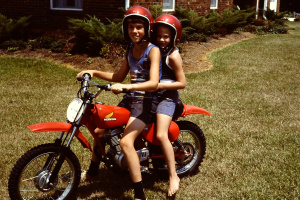 When I think about what matters most to me today – things like nature, adventure, creativity, and freedom – it takes me back to my childhood and how much those experiences have shaped who I’ve become. I’m thankful for parents who gave us this beautiful space and so much freedom to explore and play. When I consider all the risky things we did, it gives me proof that kids are surrounded by a pack of angels! I mean, in this photo, we’re about to jump a stack of concrete cinder blocks with a ramp built of plywood and 2X4s and I’m riding that dirt bike in shorts and am barefoot!
When I think about what matters most to me today – things like nature, adventure, creativity, and freedom – it takes me back to my childhood and how much those experiences have shaped who I’ve become. I’m thankful for parents who gave us this beautiful space and so much freedom to explore and play. When I consider all the risky things we did, it gives me proof that kids are surrounded by a pack of angels! I mean, in this photo, we’re about to jump a stack of concrete cinder blocks with a ramp built of plywood and 2X4s and I’m riding that dirt bike in shorts and am barefoot!
I feel these values alive in me today – mostly in my spirit and essence in how I show up in life and work, and in the particulars of my behaviors and decisions. For example, even though I live in the city now, I’m never too far from the woods, a stream, or a trail. My windows are open to feel the breeze and hear all the sounds of nature. Although my “farm” animals now are Hendrix and Fred, my Labrador and Beagle, I love a horseback ride whenever I get the chance. And three years ago, I bought a Triumph motorcycle. I love my riding and camping adventures. It’s through these experiences that I’m most fulfilled.
How have your roots shaped who you are today?
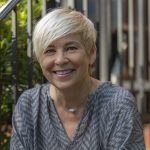
Hi, I’m Jeanie Duncan. I work with individuals and organizations as a transformation partner to help them unlock their Truth, discover authentic value, and create meaningful impact in the world. I believe when we are truly aligned with our purpose, we can live and perform at our highest potential. With over 25 years of experience as an executive, CEO, consultant, and coach, I offer strategic, knowledgeable, and experienced guidance for those who are ready to take the courageous leap toward true transformation.

Jan 22, 2015 | Focus
It topped 50 degrees last Sunday…almost enough to give me some early spring fever in January. I decided to curl up in my window seat, enjoy the warm sunshine, and savor a thought provoking read, “The Power of Less” by Leo Babauta. In keeping with his mantra, the book is brief enough to finish in an afternoon. Bonus!
Just three days later, I can’t stop thinking about his core principles. I find them so meaningful and effective that I’d like to highlight a few. I’m especially enjoying the one “simple focus.” What a difference I’m experiencing with only a few days of intentional practice. I hope you’ll give them a try too!

Set Limits
We live in a world where we’re overwhelmed with ‘stuff.’ Our homes are filled with too many things. Our days are packed with an unending string of meetings and tasks. The inbox overflows with dozens of emails. We have too much – clutter, information, tasks, and choices. It simply won’t all fit.
With a ‘less is more’ framework, Babauta encourages a life with limits. “Setting limits simplifies things, focuses our energy, highlights the important, and makes us more effective.” It’s as if time and space expand.
This week, I’m paying more attention to when and where I feel the overload and need for cutting back. I’ve turned off the distracting visual email prompts, assessed meeting invitations with a new lens and declined more than typical, and reduced the number of blogs and listserves to which I subscribe. Already, it feels freeing.
Choose the Essential and Simplify
Choosing the essential is the key to simplifying – you have to choose the essential before you simplify, or you risk eliminating things without keeping the most important. “Simplifying isn’t meant to leave your life empty – it’s meant to leave space for what you really want to do.”
For me, getting to the essential starts with eliminating the non-essential – like the quote from sculptor Michelangelo, “I saw the angel in the marble and carved until I set him free.”
However you get there, once you know what’s essential, you reduce projects, tasks, commitments, and clutter. In my work with my executive coaching clients, an important part of the process is for a client to know his/her core values, set goals, and confirm what’s most important and brings you the greatest joy.
Simple Focus
 The “Power of Less” presents focus as the most important and powerful tool – “focus on less to become more effective.” Intellectually, I get it, but practice it is far more difficult. Here’s what helps me most:
The “Power of Less” presents focus as the most important and powerful tool – “focus on less to become more effective.” Intellectually, I get it, but practice it is far more difficult. Here’s what helps me most:
- Identify the most important priorities (and tasks).
- Keep these front and center. I do this by creating an annual plan, then breaking that down by quarter, month, week, and day.
- Begin each day by focusing on the most important tasks, executing these one at a time until complete.
- Resist checking email and exploring the internet first thing in the day, otherwise I become occupied by urgent or intriguing distractions.
- Focus on the present instead of the past or future. This is so challenging! I compare it to attempting to quiet my mind during meditation. It helps to practice with the simple things in my day – eating, driving, sleeping – focusing only on that, and enjoying it. When I can do that, it feels like pure flow.
Start Small
Send your overachiever to time out! Starting small is simply a way to ensure the greatest likelihood of success for all the other changes.
Think of the fail rate with New Year’s resolutions: we start the year excited and rearing to go. Like a Thoroughbred out of the gate, we charge forward – make the first lap and maybe a second, and then start to lose steam or quit altogether. The value of setting realistic, achievable goals is important to have any chance of success.
This reminds me of when I began running. My son was in the 4th grade at the time and asked me to run with him to prepare for his school’s 1-mile event. For a week or two, we practiced together, and he accomplished his goal. Next, we decided to sign up for a local 5K. We completed it, and by then I began to enjoy running.
For the next year, I ran several community 5K events. I decided to step it up and run 10Ks the next year. Then, in year three, I trained for and ran my first half marathon. Now, eight years later, I’ve completed about ten half marathons. Starting small was key to my running success and sustainability.
Declutter
This principle begins with “A clean desk allows you to focus on the task at hand, which is key to being effective in whatever you’re trying to do.” So today, in honor of this idea, I cleaned up my office and desk. Maybe it’s just in my head, but afterward I swear I was able to think more clearly and accomplish more.
Another way I’ve practiced this principal recently is conducting a home inventory and identifying things we no longer use. We’ve made countless trips to our local Goodwill, learned how to “do eBay,” and have experienced good success in selling many items. It’s inspired us to set new goals geared toward decluttering and downsizing, like:
- Set aside time to clean out.
- Start simple – with one room, a closet, or a drawer
- Handle paperwork only once, taking immediate action (like paying a bill), filing, or tossing it.
- Have a home for everything and keep things in their place.
- For every item you bring into your home, remove something of equal size and significance.
Slow Down
Years ago, I decided to take a sabbatical for a few months. One of the first things I experienced was a much slower pace. I stepped off the frantic work treadmill, engaged in some creative pursuits, and savored the foreign white space on my calendar. My friends worried that the change was so abrupt, I would need therapy. Not the case!
Before this “time out,” my life was jam-packed. I never completed a task list, rushed everywhere I went, and felt behind, late, and exhausted. I had enthusiastically signed up for this career and professional leadership role, but I didn’t want to live my life like this.
As Babauta states in his book, “We were not made to function this way…the stresses of constant overload and a constant hectic pace for every waking moment.” The paradox is to slow down to be happier, more effective, and productive.
During my time off, I consciously slowed down. I ate slower, walked slower, drove slower. Here’s a novel idea: when you eat, just eat. Enjoy it. Savor it. Truly taste it. Try the same for driving: appreciate the complete experience of driving and notice what’s around you. Do you ever arrive at a destination and have no recollection of how you got there? My goal then and still today is to shift away from that and be fully present with whatever I’m doing. I probably fail more than I succeed, but this book is a great reminder to re-focus.
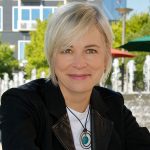 About Jeanie Duncan: Jeanie is President of Raven Consulting Group, a business she founded that focuses on organizational change and leadership development in the nonprofit sector. She is a senior consultant for Raffa, a national firm working with nonprofit clients to lead efforts in sustainability and succession planning, executive transition and search. Additionally, Jeanie serves as adjunct faculty for the Center for Creative Leadership, a top-ranked, global provider of executive leadership education.
About Jeanie Duncan: Jeanie is President of Raven Consulting Group, a business she founded that focuses on organizational change and leadership development in the nonprofit sector. She is a senior consultant for Raffa, a national firm working with nonprofit clients to lead efforts in sustainability and succession planning, executive transition and search. Additionally, Jeanie serves as adjunct faculty for the Center for Creative Leadership, a top-ranked, global provider of executive leadership education.

Nov 6, 2014 | Authenticity, Intention

I spoke at an executive women’s conference recently where the program centered around the theme of “Having it All.” Speakers and panelists offered perspectives on this topic that ranged from myth to miracle.
Often, when I hear people talk about “having it all,” the conversation is about volume…as in “super-size” me. I get this image of a caped super-human individual with the mystic powers to be a deeply devoted parent, put in 12-hours at the office, work out at the gym, manage the household, and get a full night’s rest. I don’t buy in to this steel facade of “I got this! I can do it all and have it all.” Maybe this can occur in the short-term, but it’s certainly not a sustainable nor fulfilling way to live.
What if this idea of “having it all” is instead about abundance and our making the choice to focus on what’s most important in our life? What if we paid more attention to managing our energy around what we most value, versus managing our time around our responsibilities and endless task lists. And that “I got this!” is about being an infinitely creative and resourceful human being, with both a deep internal well and rich connections and resources surrounding and supporting us.
Especially as women, it’s my sense is that we put this unrealistic expectation on ourselves to try and do it all, or worse yet, we must do it all to be successful. And we wait too long to raise our hand and ask for support. We wait until we’ve gone too far – we’ve burned ourselves out in our job, our relationships are beyond repair, we experience significant health issues, and we find ourselves completely exhausted. It’s often only then that we stop and wonder what happened.
Each of us has our own unique circumstances and resources in life. The key is to intentionally acknowledge and leverage them. I believe it comes down to three simple elements: choice, resonance, and flow.
Choice – Whether you consciously choose or not, you’re making a choice every moment. Each of us is in control of our personal choice. Why not take charge and own it? As an executive coach, I guide clients in personal visioning and planning similar to the way they typically approach this exercise within the workplace. In business, we plan – business plans, financial plans, strategic plans – but personally, we don’t often take time to reflect and think intentionally about our future.
For a moment, envision yourself five years from now, living the most fulfilled life you can imagine. What would it be like to create your vision, define your personal mission, and develop an action plan to get there? Whether you take this kind of approach or not, you are exercising choice. It takes conscious practice and commitment to choose a path of fulfillment.
Resonance – When I think of resonance, I think of depth and alignment. You know when you have it – resonance – and when you don’t – dissonance. It starts with knowing your core values. Values, like a keel, are the shape of your life beneath the surface that keeps you on course. Without it, you drift and shift directions with the wind. Another way to examine this is to ask, “What makes you tick? What are the must have’s in your life?” Mine are: connection, adventure, creativity, nature, wellness, spirituality, and independence. Know yours, and when you feel adrift it’s a place to look.
Flow – Just like it sounds, flow is about energy and movement. Webster’s defines it “To proceed smoothly and readily, steadily and easily.” Flow is about taking each moment as it comes and being within it, allowing the energy and emotion to move through you. It is within this that we are provided our guidance. When things in your life feel “off,” usually there’s something interfering with this natural flow.
These three simple elements of choice, resonance, and flow can be quite challenging in actual practice. For example:
- I get wrapped up in my day-to-day busyness and priorities and forget I have choice.
- Business travel picks up, the schedule is intense, and I forget to honor my core values. Very quickly, I feel the dissonance – I’m in overdrive, I get tired, and I don’t make time for important things like getting enough rest and working out.
- When I have a presentation to make, I sometimes gravitate to a podium where I feel safe relying on my note cards. Quickly, I get too focused on following my outline and fail to be open and connect with my audience. Goodbye flow.
The reality is that you don’t wake up one morning and say, “I need more choice, resonance, and flow in my life.” Instead, you wake up and you’re burned out, exhausted, unhappy, wandering, or stuck. This is how it shows up. Yet, when you peel back the layers, these outcomes often result from not exercising our choice, not being in resonance with what matters most, and failing to allow your true self to flow.
“Having it all” is about choice and knowing that we are naturally creative, resourceful, and whole human beings. Having it all is not shouldering it all yourself. It’s about knowing you have all you need to achieve everything you desire both within you and within your immediate grasp.
Read other related blog posts:
Whole Life Balance – Creating Flow and Alignment
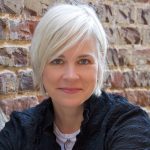 About Jeanie Duncan: Jeanie is President of Raven Consulting Group, a business she founded that focuses on organizational change and leadership development in the nonprofit sector. She is a senior consultant for Raffa, a national firm working with nonprofit clients to lead efforts in sustainability and succession planning, executive transition and search. Additionally, Jeanie serves as adjunct faculty for the Center for Creative Leadership, a top-ranked, global provider of executive leadership education.
About Jeanie Duncan: Jeanie is President of Raven Consulting Group, a business she founded that focuses on organizational change and leadership development in the nonprofit sector. She is a senior consultant for Raffa, a national firm working with nonprofit clients to lead efforts in sustainability and succession planning, executive transition and search. Additionally, Jeanie serves as adjunct faculty for the Center for Creative Leadership, a top-ranked, global provider of executive leadership education.

Sep 29, 2014 | Career, Coaching, Leadership

I believe deeply in the value and impact of coaching. Yet in my work, I’ve discovered that many people have never had a coaching relationship and aren’t quite sure what to expect. I would like to share more about leadership coaching, possibly dispel some myths, and offer perspective about when it might be right for you.
One way I like to think of leadership coaching as similar to how an elite athlete uses a coach. A good coach helps leaders develop clarity of purpose and focus on action. The relationship is a formal engagement in which a qualified coach works with an organizational leader in a series of dynamic, confidential sessions designed to establish and achieve clear goals that result in improved effectiveness for the individual, and often for his or her team and organization.
And to better understand what coaching is, it can be helpful to briefly highlight what coaching is not:
- Counseling or therapy, which is focused on insight into history, psychological healing, pain resolution, and coping mechanisms.
- Consulting, where a consultant offers external expertise to assess, analyze, and offer technical advice or recommendations to solve a particular problem or challenge.
- Training, with the intended outcome to impart knowledge from an expert to a student where the student gains or sharpens specific skills.
Every coaching relationship is unique due to the specific situation of the person seeking coaching and the coach’s approach. However, there are some key elements you can expect with the engagement.
Contracting – This refers to everything that’s involved in setting up the actual coaching relationship and the overall process, from when and how often to meet, whether you’ll meet in-person, by phone or other virtual platforms, to fee structure and billing, and how to handle appointment scheduling and changes.
Boundaries and Confidentiality – This includes such elements as how information is handled (confidentiality and report expectations) and how the coaching relationship fits into the existing network of relationships. Information provided by the client is kept strictly confidential except as otherwise authorized in writing by the client. For example, the coach and client may agree that the goals or results of the coaching work can be reported to his/her boss or other organizational representative. Also, the coach may support the client in preparation of reports he/she makes to a boss or other stakeholder.
Mutual Role Clarity – A primary value your coach brings is helping you decide and act more effectively, not thinking or deciding for you. Your coach will be an ally, supporter, and sounding board. You can expect him/her to be direct and honest, asking powerful questions and making empowering requests that support your desired outcome. As the client, you’ll get the most from your coaching relationship if you show up engaged, willing to examine yourself – your values, beliefs, behaviors, and impact, and are open to make changes necessary to become more effective. Its important to realize that coaching is a comprehensive process that takes time and may address any area of your life, including specific career aspirations, business projects, leadership, or personal topics such as finances, health, and relationships. Even if your coaching engagement is formed in a professional work context, you bring your full self to the experience and therefore “whole life” is taken into account.
I first hired a coach when I was considering applying for a top leadership position in my organization. I wanted to pursue the opportunity and felt I needed a partner with whom to review it from all angles – someone removed from the situation, who would ask me thought-provoking questions, and help me confirm that I was the right person at the right time.
Since that first experience, I’ve hired coaches over the years and now make it a part of my ongoing personal and professional development to retain a coach. The following are some situations where a coach can be particularly helpful:
- You and your organization are experiencing significant change and transition.
- Your organization is not growing as you believe it could.
- You’re unclear on where you need or want to be in five years.
- You’re experiencing increased complexity in your role and organization.
- You seek a confidential, safe space where you can express concerns and challenges.
- You are working too hard for the results you’re getting.
- Stress is taking toll on your health and relationships.
- You’re not spending time on the most productive tasks.
- You haven’t been able to build a great team you trust and that works well together.
- You’re not enjoying your work as much as you once did.
- You struggle with whole life balance.
Using a leadership coach as a developmental partner provides a rich opportunity to learn, reflect, change, and grow. Like any relationship, it’s important to know what to expect and to co-create a constructive alliance. Through your work together, you develop the skills, behaviors, and knowledge enabling you to increase your effectiveness.
 About Jeanie Duncan: Jeanie is President of Raven Consulting Group, a business she founded that focuses on organizational change and leadership development in the nonprofit sector. She is a senior consultant for Raffa, a national firm working with nonprofit clients to lead efforts in sustainability and succession planning, executive transition and search. Additionally, Jeanie serves as adjunct faculty for the Center for Creative Leadership, a top-ranked, global provider of executive leadership education.
About Jeanie Duncan: Jeanie is President of Raven Consulting Group, a business she founded that focuses on organizational change and leadership development in the nonprofit sector. She is a senior consultant for Raffa, a national firm working with nonprofit clients to lead efforts in sustainability and succession planning, executive transition and search. Additionally, Jeanie serves as adjunct faculty for the Center for Creative Leadership, a top-ranked, global provider of executive leadership education.
Jan 19, 2012 | Career
I had the pleasure last week of organizing and moderating a panel presentation to Greensboro’s Women’s Professional Forum: “Navigating Your Career with Intention: knowing when to make a change and having the courage to leap.” Michelle Clark, Laurelyn Dossett, and Kathy Ridge came together sharing their personal journey of career transition.
Both Michelle and Kathy are former corporate executives who now have launched their own independent endeavors: Michelle, as a soon-to-be published author, and Kathy as founder of her own consulting practice. Laurelyn has followed her lifelong passion of music, becoming an acclaimed musician, singer, and songwriter.
Their stories revealed the underlying currents that sparked a change in direction, propelled them to action, and gave them courage to close one chapter and open a new one.
While each was unique, the collection of experiences shared presented gems of commonality:
- Live awake. We all have an internal compass that will guide us if we simply pay attention. And listen.
- Know who you are. This is not about the various roles each of us serves, but rather, “who am I, really?” Allow this and your core values to drive you.
- Live with the end in mind. We all have a story to tell. How will yours end? What mark will you leave? How does this guide you in the present moment?
- Living your life with purpose and intention starts with one small step. What step will you take today? Tomorrow?
- Believe in yourself and your own best work. Unconditionally.

 Growing up on a farm, my big brother, Lee, and I filled our days playing with cows and horses, riding our dirt bike, fishing tadpoles out of the creek, and making forts from hay bales that filled our big red barn…the structures soon to became territory for our slingshot battle. The fact that neither of us is blind today truly is a miracle.
Growing up on a farm, my big brother, Lee, and I filled our days playing with cows and horses, riding our dirt bike, fishing tadpoles out of the creek, and making forts from hay bales that filled our big red barn…the structures soon to became territory for our slingshot battle. The fact that neither of us is blind today truly is a miracle. When I think about what matters most to me today – things like nature, adventure, creativity, and freedom – it takes me back to my childhood and how much those experiences have shaped who I’ve become. I’m thankful for parents who gave us this beautiful space and so much freedom to explore and play. When I consider all the risky things we did, it gives me proof that kids are surrounded by a pack of angels! I mean, in this photo, we’re about to jump a stack of concrete cinder blocks with a ramp built of plywood and 2X4s and I’m riding that dirt bike in shorts and am barefoot!
When I think about what matters most to me today – things like nature, adventure, creativity, and freedom – it takes me back to my childhood and how much those experiences have shaped who I’ve become. I’m thankful for parents who gave us this beautiful space and so much freedom to explore and play. When I consider all the risky things we did, it gives me proof that kids are surrounded by a pack of angels! I mean, in this photo, we’re about to jump a stack of concrete cinder blocks with a ramp built of plywood and 2X4s and I’m riding that dirt bike in shorts and am barefoot!









Recent Comments